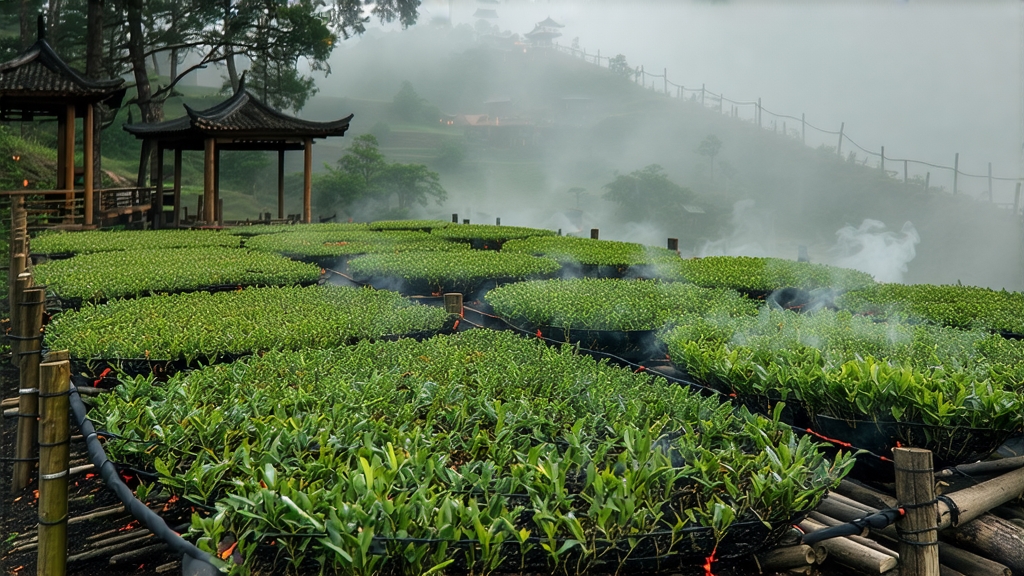
When European tea clippers first rounded the Cape of Good Hope in the late seventeenth century, the fragrant cargo they hurried toward London was not the familiar green leaf of Cathay, but a dark, almost black twist that unfurled in porcelain cups to reveal a liquor the color of burgundy and the perfume of a campfire in a pine forest. That tea was Lapsang Souchong, the original black tea of China, born in the granite gorges of the Wuyi Mountains of northern Fujian. Today, while the world associates “black tea” with Assam or Ceylon, connoisseurs still journey to Tongmu Village, population fewer than two thousand, to taste the pine-smoked ancestor whose very name—lapsang in the local Minbei dialect means “pine wood,” and souchong refers to the fourth or fifth leaf plucked—carries the memory of its birthplace.
History: From Ming-Era Accident to London Drawing Rooms
Legend places the birth of Lapsang Souchong during the late Ming dynasty, around 1646, when a passing army commandeered a tea factory in Xingcun, delaying the usual drying schedule. To save the oxidizing leaves from ruin, workers rushed them over fresh pine fires, inadvertently infusing the leaf with resinous smoke. The Dutch, and soon after the British East India Company, adored the result, paying twice the price of green teas. By 1669 the Company listed “bohea” (the corruption of “Wuyi”) as its costliest import; Samuel Pepys drank it; Queen Anne pronounced it “brisk and fragrant.” Thus, the first black tea ever exported became the prototype for every subsequent black tea style, from Keemun to Darjeeling.
Terroir: Why Only Tongmu Can Birth Authentic Smoke
The Wuyi range is a UNESCO biosphere reserve where subtropical mists rise from the Jiuqu (“Nine Bends”) Stream, wrapping cliffs of weathered tuff and granite. Day-night temperature swings of 15 °C slow leaf growth, concentrating amino acids and volatile oils. Crucially, Tongmu sits inside a national forest where Chinese red pine (Pinus massoniana) and cedar (Cunninghamia lanceolata) are protected; only deadfall may be gathered, ensuring resin-rich but sustainable fuel. Outside this 600-meter core zone, identical cultivars and techniques yield “outside mountain” teas that lack the sweet coolness and longan-fruit finish of true Tongmu.
Cultivars: The Subtlety of the “Small Leaf”
Most Lapsang is made from the indigenous Xiao Ye Zhong (“small leaf species”), a shrub whose narrow leaves resemble myrtle. Within Tongmu, two clonal selections dominate:
• Zheng Shan Xiao Zhong – the classic bush, cold-tolerant, yielding malt and honey even before smoking.
• Jin Guan Yin – a natural hybrid whose golden buds add ripe-peach sweetness to the final cup.
Gardeners let the bushes grow waist-high, shading them with towering pines so that only 10 % full sun reaches the leaves, forcing the plants to manufacture more chlorophyll and theanine, precursors to both umami and smoke adhesion.
Plucking Standard: The Forgotten “Souchong” Leaf
Unlike modern black teas that chase only buds, authentic Lapsang Souchong relies on the souchong tier—two leaves and a robust bud, or occasionally three mature leaves—picked when the leaf has lost its grassy edge but still snaps crisply. The larger surface area absorbs smoke evenly, while the thicker cuticle prevents over-firing. Picking occurs from Qingming (early April) to early May; rain-day plucks are rejected because surface moisture dilutes smoke signature.
Craft: The Five-Act Drama of Smoke and Fire
Withering: Leaves are spread 3 cm deep on bamboo screens set above ground-level qinglong (“green dragon”) trenches. A gentle fire of pine embers 80 cm below raises the ambient temperature to 28 °C for 8–10 hours; convection, not direct heat, desiccates the leaf edges while pine volatiles begin to adhere.
Rolling: Once the leaves feel leather-dry, they are rolled for 45 minutes under 6 kg mechanical pressure, rupturing cells to release catechins and polyphenol oxidase. The juice mixes with pine vapor, forming the precursor of smoky phenols.
Oxidation